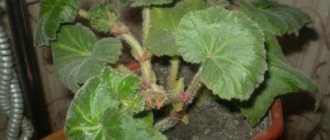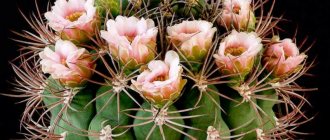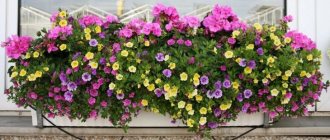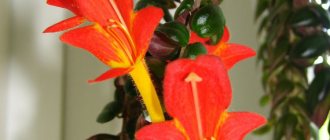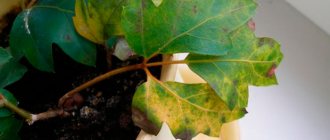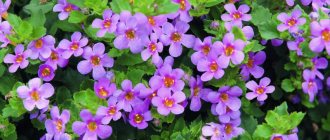How to care?
When growing fuchsia at home, you must follow certain rules and create comfortable conditions that will ensure the plant a long life, enjoying long and lush flowering.
So, how to care for this flower so that it blooms?
We talked in detail about the subtleties and nuances of growing fuchsia and caring for it at home in this article.
Choosing a pot
What size should the pot be? You should not plant fuchsia right away in a large pot. She can't stand too much space, but she can't stand being cramped either. Starting growing from a small shoot, you should choose small dishes, the size of a plastic glass. As the flower grows and its root system expands, it should be transplanted into a looser pot.
REFERENCE! Plastic pots with large drainage holes are best suited for planting fuchsia. Clay pots are also suitable, but when using them, more frequent watering will be required, since the water in them evaporates not only from the surface of the soil, but also through the walls.
Soil composition and proportions
An important criterion when choosing soil for planting fuchsia is the ability to pass air to its root system; it must be sufficiently loose. What land does he like? For fuchsia, a slightly acidic ready-made universal soil with a pH level of no higher than 6.0 is suitable. It should be the same as for indoor plants and contain peat, ash, sand. You can also prepare an earthen mixture yourself, you just need to maintain the following proportions:
- leaf soil, peat, sand (3:2:1);
- turf soil, compost, humus (2:1:1).
To prevent the roots of the plant from rotting, it is necessary to use drainage, which will ensure that there is no stagnation of water. Small pebbles, expanded clay or broken bricks may be suitable for this.
Air humidity
In the room where fuchsia will grow, you need to set the humidity level within 40-60%. During the period of active growth, the plant will require additional moisture. This can be achieved by spraying the leaves with a spray bottle twice a day - morning and evening. At the same time, make sure that the flower is not exposed to direct sunlight, which can lead to burns.
What to do with the flower in autumn and winter (read here about how to preserve fuchsia in the basement and in the apartment in winter, and from this article you will learn whether it is possible to prune a bush for the winter and how to carry out the procedure)? There is definitely no need to spray, but to maintain optimal air humidity, you can use a container of water placed next to the pot.
Lighting and location
The most correct placement of a fuchsia pot will be rooms located on the southwest or east side. Having placed the plant indoors on the south side, it is worth placing the pot not on the windowsill, but on a table or shelf next to the window, thus protecting it from direct sunlight. When placing fuchsia near a window on the north side, you should be prepared for the fact that the plant will bloom weaker and stretch out more. Drafts in fuchsia can cause its leaves and buds to fall off.
Important! During the period of formation, blossoming and flowering of buds, in no case should you rearrange the pot with the bush, this can lead to the fall of all the flowers and buds.
Fuchsia is a light-loving flower, but prefers soft, diffused light. It tolerates morning and evening sun rays without consequences, but it should be protected from the hot rays of the sun during the day by covering the pot or shading the window.
Temperature
Fuchsia is a rather demanding plant regarding air temperature. During the period of active growth and flowering, the plant prefers to be warm; in summer and spring, the optimal comfortable temperature will be 18-25 degrees, but it is very important that the temperature does not exceed 30 degrees, otherwise this can lead to wilting of the leaves and falling off of buds and flowers.
In winter, fuchsia goes into a dormant state; during this period, the comfortable temperature will be 10-12 degrees. In an apartment, a pot with a plant can be placed on an insulated loggia, where the temperature does not drop below 3 degrees.
Watering
Proper and timely watering is the main condition for growing fuchsia. The amount of moisture needed and the frequency of watering depend on the time of year and the condition in which the plant is.
In winter, when fuchsia is at rest, it should be watered no more than 2-3 times a month, provided it is in a cool place. If the flower overwinters at room temperature, then the number of waterings should be increased to 3-4 times a month. With the onset of spring and until autumn, when fuchsia enters the growing season, it needs to be provided with abundant regular watering, while avoiding stagnation of water near the roots, which can lead to their rotting and death of the plant.
Flowering plants have the greatest need for water. When watering fuchsia, you should use warm boiled water, without the presence of chlorine impurities.
Now you know how to preserve fuchsia. It is enough just to create the appropriate conditions for it.
Soil preparation
The first thing you should pay attention to when growing this flower is the soil. It can be purchased at a flower shop
For fuchsias, ready-made specialized mixtures for flowering plants are suitable. They have a normal, non-acidic environment, which is ideal for growing strong and viable sprouts. Experienced gardeners prefer to prepare the soil mixture themselves. Today there are 3 known methods:
- a mixture of peat, perlite and sand. They are needed in equal parts;
- crushed sphagnum moss, humus (preferably rotted) and vermiculite to make the soil loose. The components are mixed in equal proportions;
- a mixture of turf, peat, pine bark, sand. The components are prepared in a ratio of 3:1:1:1, respectively.
Before planting, the soil must be disinfected. A weak solution (light pink) of potassium permanganate is suitable for this. During processing, thrips and nematodes are killed, and the likelihood of mold and pathogenic microflora formation is reduced. If you have a special drug “Fitosporin”, it will successfully replace a solution of potassium permanganate.
The container does not play a special role for growing seedlings. The most commonly used are plastic cups or wide containers. The main condition for a container is the presence of a large number of holes for water to drain. A drainage layer (2-3 cm) can be laid at the bottom of the container. Expanded clay or small pebbles are suitable for this.
Important! Do not allow fluid to stagnate
Fertilizers
We'll tell you how to feed fuchsia for abundant flowering.
To achieve lush and beautiful flowering, fuchsia must be regularly supplied with fertilizers during the growing season. What elements should the supplement contain:
- Young plants need fertilizers rich in nitrogen, which promotes rapid growth and a bright green color.
- An adult plant should be fertilized with fertilizers containing potassium and phosphorus, which ensure lush, abundant flowering.
Organic fertilizers are also suitable for fuchsia, but they should still be alternated with mineral ones. Before fertilizing, you need to make sure that the soil in the pot is sufficiently moist. Experienced gardeners advise applying fertilizer every 2 weeks. Otherwise, too much fertilizer can lead to the growth of leaves, but the flowers on it will become rare.
IMPORTANT! In winter, when the plant is dormant, the use of fertilizers should be stopped.
You cannot use fertilizer for the following fuchsias:
- Sick plants.
- Young cuttings whose root system is not yet fully formed.
Popular varieties
There are many varieties of fuchsia that are very popular. Let's look at the features of some of them.
"Annabelle"
White princess in the kingdom of fuchsias. This beauty amazes beginners in floriculture with its fragile and delicate appearance. The flower has a snow-white skirt with pink stamens. The leaf blades are light green in color, but when ripe they darken noticeably.
The variety is characterized by early flowering and active growth. Often people choose “Anabelle” for cultivation precisely because of these factors.
Delta Sarah
Ampel type variety. It is winter-hardy. It is distinguished by beautiful large flowers that always attract a lot of attention. The plant has a strong structure and active growth. Ideal for growing yourself or selling as a showy perennial.
The flowers of this variety are semi-double, colored white and blue. You can’t just walk past the charming flowers without admiring them.
"Waist"
A very beautiful plant that looks interesting. "Talia" is distinguished by rich orange buds. This variety, like those described above, is famous for its active and lush flowering, which continues throughout the spring and autumn seasons.
Flower growers are attracted to “Talia” for its decorativeness and brightness. Its buds are graceful and variegated. This rich bushy plant can grow up to 50 cm. The leaf blades of the flower are velvety with an interesting reddish tint.
"Bella Rosella"
This fuchsia variety is famous for its versatility. A flower can grow at an amazing speed if it is provided with optimal conditions. The shoots of "Bella Rosella" grow very quickly and are unbreakable.
The flowers of representatives of this variety grow quite large. They are characterized by a rich pink (even purple) color of the skirt. The crown of sepals is always very delicate - white and pink. All of the above details form a very beautiful and lush bush. This attractive and elegant flower can decorate any collection.
"Royal Mosaic"
One of the most popular and widespread varieties. Flower growers are happy to grow “Royal Mosaic”, since this plant is characterized by lush and fragrant double-type flowers. The buds are very original - this applies to both color and shape. The skirt has a blue-violet color, rich in tone. This color is offset by a pink underside. Thanks to this color effect, the plant looks very unusual and beautiful.
"New Millennium"
Another decorative variety that is hard not to fall in love with. "New Millennium" is characterized by a very unusual and vibrant appearance. The plant is bushy and branches quickly and well. Easy to shape.
The flowers of this variety look especially beautiful and impressive with the onset of the flowering period. The plant has thin leaf blades of a light green hue, and large lilac buds look great against their background. When the double flowers bloom, showing everyone an unusual color palette, this plant becomes truly luxurious and vibrant.
Photo
In the photo you can see what fuchsia looks like.
If a flower grows in the garden
Caring for fuchsia may vary slightly depending on where you decide to grow it: at home in a pot or in the garden, outdoors. Creating comfortable conditions in the garden is just as important as when growing in a pot at home.
An important criterion when growing fuchsia in the garden is the choice of planting site. Unlike home breeding, it will not be possible to move or rearrange the flower in the garden. Therefore, you should immediately choose windless and well-lit corners of the garden, with sufficient humidity, sheltered from direct sunlight.
We talked in detail about growing fuchsia in the garden and subsequent flower care in this article.
Features of fuchsia
Under natural conditions, fuchsia grows in mountain crevices and forests.
Fuchsia is a small tree or shrub with flexible reddish shoots and small green leaves. In nature, this plant is found in America and New Zealand. A special feature of fuchsia is its flowers, consisting of a calyx and a corolla.
This plant is absolutely safe for children and pets. Its fruits are edible and can be added to various desserts.
This is an unpretentious plant that even an inexperienced gardener can grow. This indoor flower will not only decorate any interior, but will also help create a favorable aura in the house. According to superstitions, fuchsia helps develop intuition and gives inspiration to creative people.
The shades of purple in the palette are named after this plant.
The color of fuchsia is considered to be a purple hue. But in fact, it is a collective definition of several shades of purple: from pale crimson to deep violet.
Photo: interior use
Fuchsia will fit perfectly into the living room interior
You can also grow fuchsia as a hanging plant by hanging a flower pot on the terrace or balcony
Fuchsia will decorate the window sill in the kitchen
Growing
In order to guarantee a plant a long beautiful life, it is necessary not only to provide it with proper care, but also to carry out some important procedures throughout the year.
Reproduction
Fuchsia reproduces in three ways:
- Seeds. This method is mainly suitable for breeders, as it is quite labor-intensive. Its main condition is artificial pollination of the mother plant.
- By cuttings (propagation by cuttings) . It is necessary to separate young cuttings 10-20 cm long from the plant, remove the lower leaves, then place the cuttings in water and cover with a bottle or bag. After the roots appear, approximately 5-10 days later, they can be planted in prepared soil.
- Leaves. A leaf with a stem is torn off from the plant, placed in the ground, and it must be regularly sprayed with water. After 1-1.5 months, shoots will appear at the cut site, after which you can stop spraying.
For more details on how best to plant a flower - with seeds or cuttings, read this article.
Transfer
Growing fuchsia involves annually transplanting the plant into a larger pot, which ensures its further development and the production of seedlings for propagation.
How to form correctly? The plant is transplanted into a new pot using the transshipment method. Very carefully, trying not to damage the root system.
Be sure to add new soil along the edges of the pot and water it abundantly. Leave the watered fuchsia on a light windowsill without direct sunlight.
Read more about how to transplant fuchsia in our material.
Selecting and purchasing seeds
By purchasing fuchsia seeds at a flower shop, you can grow a wide variety of hybrids and varieties of this plant. Fuchsias “Holiday” and “Foxtrot” are very popular, presented in a variety of color variations.
When choosing seeds, you should keep in mind that for best germination they must be fresh. It doesn’t hurt to choose seeds from well-known companies that have earned the trust of customers.
It should be remembered that when fuchsia is propagated by seeds, the plant may lose varietal characteristics.
If the gardener has an adult flowering plant, you can get seeds by artificially pollinating it and collecting oblong seed pods in place of wilted flowers. Moreover, if you use several different varieties for pollination, you can eventually grow fuchsia with a unique color.
Diseases
Fuchsia has a fairly strong immunity to various diseases and pest attacks. If the growing conditions are not met, fuchsia gets sick:
- Falling leaves. The reasons are lack of light, watering or excess dry air.
- Falling flowers. Occurs due to irregular watering, as well as the location of the pot on the sunny side.
- Yellow stripes and brown spots on foliage. They are a consequence of waterlogging of the soil in winter. If you want to know how to care for fuchsia in winter, remember: it does not tolerate overwatering.
- Short flowering season. Various factors can influence: lack of light, fertilizer, moisture, too warm room.
Fuchsia is a rather unpretentious flower for home cultivation, but when growing it, you should not ignore certain factors. By creating comfortable conditions of temperature, watering, lighting, and fertilizer for this beauty, there is no doubt that fuchsia will become a source of pride for its owners and will reward it with lush and bright flowering.
Propagation of a flowering plant
The abundantly flowering fuchsia can be propagated from green cuttings, seeds and leaves . Let's look at these methods in more detail.
Cuttings
If the choice fell on fuchsia cuttings, then 5-8 cm of stem cuttings are chosen for these purposes. They are planted several at a time in containers approximately 12 cm in diameter. Next, the pots should be placed in a small greenhouse for subsequent germination.
Cuttings are often rooted using water with the addition of activated carbon . The pots are covered with film on top, removing it from time to time for ventilation. To plant the cuttings, you should wait until the roots form 1.5-2 cm.
We recommend watching a video about fuchsia cuttings:
Seeds
When propagated by seeds, fuchsia germinates approximately 50 days from planting. You must first prepare suitable soil by mixing peat and sand. After a month, the grown plant should be pruned. How to plant seedlings? They are planted in pots of 5-6 pieces, not forgetting to pinch the top first to improve branching.
Leaves
When propagating using leaves, the most developed leaves with the stem are removed from the mother plant and planted in soft soil, covered with film on top.

